by Nic Haygarth | 13/11/16 | Britton family history, Circular Head history
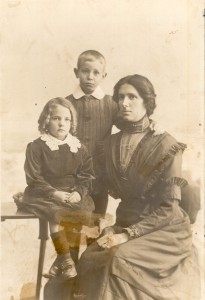
Annie Britton with Lorna (left) and Phil (centre) c1913. Yeomans and Co photo, Melbourne.
After a couple of years at Christmas Hills, in about 1912 the Brittons sold their little farm to Charlie Wells and moved to a vacant mill worker’s cottage about four kilometres away next to their mill at Brittons Swamp. This was their home for a decade as the business was established.
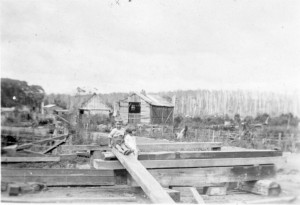
The loco shed (centre) near the mill, with the old chaff house and the hut known as Buckingham Palace to its left in the background.
The big social events of the year for people in the Christmas Hills area were the Boxing Day Picnic, New Year’s Day and, from 1923, the Easter Sports. The Boxing Day Picnic in Tommy Rowe’s paddock featured children’s foot races, tugs-of-war and a concert or theatrical performance by the kids of the school. The real competition, however, was between the ladies, trying to outdo each other with their hams, poultry and Christmas pudding spread under a huge marquee. People came in jinkers (two-wheeled carts for two or three passengers), buggies (two- or four-wheeled carriages for two people drawn by one or two horses), spring carts (two-wheeled carts without sides), on horseback or on foot. Often the road had to be cleared of fallen trees ahead of the event. No alcohol was available, but, almost as sinfully, dancing was indulged in till next morning.[1] Many a courtship began in that paddock. One young couple from Smithton set tongues wagging by disappearing hand-in-hand into the nearby forest for several hours. For kids the lolly scramble was a highlight:
Tommy Hine, the life of all picnics and parties, would take a huge tin of boiled sweets and bang loudly on the side, calling for the kids to rally round. Then he’d throw handfuls of sweets into the crowding children for them to pick up as many as they could find.
The New Year’s Day outing began well before sun-up, when Annie began to organise the whole family:
The cows would have to be milked and sent out, fowls fed, and the horse which was harnessed in the jinker and packed with our picnic basket had to be caught. The fire had to be lighted [lit], and breakfast prepared before we could start the journey to Smithton … the corduroy over the Mowbray Swamp always [being] taken at walking pace.
They had to reach Smithton by 6 am to catch Bill Boote’s motorboat down the Duck River to Seven-mile Beach.[2] Lorna remembered this as
a great adventure to us children as the boat was skillfully guided around the river’s winding watercourse. The air smelt of salt, and the water rushing by was constantly changing, colours of green and blue with white wings [being] flung up by the prow as the ship encountered opposition from the incoming tide.
When a sandbar was reached near the mouth of the river, preventing further progress, a dinghy was brought alongside the vessel to ferry the women and children ashore:
It was not an easy task for the ladies, who dressed in long frocks, but the men enjoyed helping the frightened ones (especially the pretty ones). Clasping them in their arms, they’d squeeze them more than was needed before they set them on terra firma …
The long beach was sheltered by boobyallas. AJ ‘Pelican’ Grey supplied lemonade and other cordials. He was so nicknamed because of his pelican brand lemonade bottles. These contained marble stoppers which had to be pushed into the neck of the bottle in order to release the liquid.
Sports events were held at the New Year’s Day picnic. One year when he was eleven or twelve Phil had a go at the foot running.
I had some bigger boys to compete against, but I came in first, to the amazement of others as well as myself. I seemed to have wings. The prize was only perhaps sixpence or a shilling but it was nice to beat the town lads who I knew only slightly. We lived in the bush with little or no contact with town life.[3]
Lorna remembered a small disaster that befell Annie one year on Seven-mile Beach:
One year Mother was dressed in a beautiful white dress, full length, nipped in at the waist with a waistband. She was wearing a beautifully engraved watch suspended from a gold chain around her neck. It was slipped into the waistband, the fashion at the time … Mother’s watch was a gift from her father, I think, and the pride and envy of many women … someone said to her, ‘There’s something on your neck’.
Mother, thinking in alarm that it could be a spider, rose quickly to her feet and banged her neck area. The watch broke loose and disappeared in the sand and, even with no effort spared, we failed to find it. Mother was inconsolable and, taking us with her, went for a walk along the beach to find shells which were pretty, as well as some to take home for the fowls (shell grit) in a bag. She also got a leech on her leg, a huge one. To get it off she pulled at it and, being full of blood, it burst, and her beautiful white dress was in a horrible state.[4]
Bringing home the meat
The link with the outside world was maintained by Phil and Lorna, who operated the ‘pony mail’ on Ante, a sturdy pony ‘black as coal’. Two or three days a week after school they collected the mail from the Christmas Hills Post Office (the Hine residence). On occasions, to fill in time while waiting for the mail to arrive, they visited the farm of Cornish immigrants the Rowe family, where Phil tasted his first Cornish pasty. Sometimes it would be 8.00 pm before Phil and Lorna arrived home:
The people who ran the carry mail service were wonderful to us, and would give us food and drink, and even bed us down for the night if they considered we were in danger of falling trees in a wind storm. One day the man of the house loaded us up with the usual meat load and any other provisions—two sugar bags tied together and slung over the pony’s neck as evenly as possible—and tossed us up behind, and I heard him say ‘Jee! Those Britton kids are tough. It’s as black as your hat outside.’ But we had Ante and, as he knew all the little side-tracks to avoid deep mud holes in the road, we were not very scared. The occasional branch or tree falling or a native animal jumping across the road (in my imagination only, perhaps) would make me shudder and cling more tightly to Phil up front.
There would be stops to open gates and deliver parcels, and sometimes they would take the shorter route down the tramway which, however, was dangerous in wet weather when the line might be submerged by water. A clever pony made them feel more secure:
I’ve known Ante to place his feet on the timber rails to avoid holes in the path as he smelt his way through. Ponies are very sensitive and clever really. He could push a wire fastener off a gate, open it, and turn around so that we could reach and pull the gate shut without getting off.[5]
Parcels of meat would be secured in saddlebags, but if a parcel was dropped in the dark it would be hard to find or re-secure. On one occasion Phil rode a draught horse named Boxer to school in order to bring a large cut of beef home after school. The meat was so big and heavy that it had to be lifted up to Phil on the back of the horse and balanced in front of him. But
it was a dark wet night. I was getting near home. The road was full of little holes and wet and slippery. The horse stumbled and I lost my balance. The meat fell off in the mud … My reputation was somewhat impaired, and so I gave Aunty [Kate, the Brittons’ housekeeper at the time] the horse and she had one of the men go out and get the meat out of the mud–all in a night’s work.[6]
Like nearly all early 20th-century bush farmers, the Brittons snared wallaby, pademelon and possum for extra income and, in the case of the wallaby or pademelon, extra meat. They pegged out the skins to dry on flat boards awaiting the visit of the skin buyer.
Other marsupials were less welcome. One night a quoll got into the lean-to which housed the meat safe, and when Elijah chased it, it ran into the sitting-room where the family was gather around the fire. ‘Mother grabbed me and rushed into the bedroom’, Lorna remembered. ‘She didn’t know if it was dangerous or not, I suppose’. Elijah battered it to death while it growled at him from the top of the organ.[7] Since the animals were regarded as fowl killers, no mercy was granted them.
Lorna and Phil thought they heard the ‘cough’ of ‘hyenas’ (Tasmanian tigers or thylacines) as they rode their pony home at night, although they never saw one.[8] In about 1917 Wynyard marsupial dealer James Harrison paid £5 each for three thylacine cubs secured by the Rowe brothers of Brittons Swamp after the mother thylacine had drowned while caught in a snare.[9] Lorna recalled that the Rowes had two fireside chairs backed with ‘tiger pelts’.[10]
Phil goes to finishing school
Phil was the first to go away to school. He was a sickly child, and Annie hoped his health would benefit from finishing his education with two years at Scotch College in Launceston.[11] This promoted Lorna to the front seat on Ante for mail and parcel collection. Annie was terrified of bushfires, and it was lucky that she was away settling Phil into boarding when a fire threatened the mill and the timber stacks. Lorna was returning down the tramway from the Christmas Hills with a parcel of meat when a fire fighter hurried out of the smoky gloom.
He shouted at me, as if I were to blame, as he rushed past, ‘The swamp’s on fire and before the night you will be lucky not to be burned out’. Nevertheless I was going home, fire or no fire.
Auntie Florrie had assumed control of the kitchen, feeding the fire fighters. The meat parcel suddenly looked meagre as Florrie and Lorna prepared a meal:
Uncle Mark [Britton] had collapsed, overcome by smoke in the thickest and most dangerous area, and he was brought in to rest a while. I got him a billy can of milk and water, his favourite drink, and he was soon ready for attack again. I remember him in his own way of saying thanks—‘Ah, good, this is the best drink, better than that old tea with tannin in it’. Lighting up his smelly pipe (which was full of nicotine, if he had thought about it), he gave me a cheeky grin and disappeared into the smoky area. We didn’t get burned out, but fires smouldered for days.[12]

Annie and the Britton kids, 1921. (Left to right): Phil (in Scotch College uniform), Lorna, Ken (on Annie’s lap), Annie, Frank, Eva.
Lorna’s first ride in a motor car was in 1921, when Annie took her children to visit her retired parents at Middle Brighton in Melbourne. Phil was at Scotch College, but three-year-old Frank Lindsay Britton (born 1918) and one-year old David Kenneth Britton (known as Ken, born 1920) made the trip. From Smithton they travelled to Burnie in Joey Morton’s twice-weekly Model T Ford service:
I was terrified … and held on tightly when the engine was started and away we sped, followed by a dog barking furiously. Joey Morton said not to worry as we would soon lose it when we got around on to the straight where we could do 25 miles [40 kilometres] per hour.
The return Bass Strait crossing on the Marrawah, the tiny Holymans steamer, filled both Lorna and Annie with apprehension. Annie was a poor sailor. Lorna thought, ‘Well, I’ll be able to help with the children anyway’, but soon both were seasick. Frank was sick on the toilet floor, whereupon, as Lorna recalled,
The stewardess, a harsh-tongued woman, shouted at me to clean it up, but as I had nothing excepting the toilet paper to do this I grabbed Frank and quickly retreated to our stuffy cabin.
Fresh air and calmer seas revived the Brittons next day, enabling them to watch the stevedoring work at King Island. Through the afternoon they passed Hunter and Three Hummock Island, and in the evening a full moon provided a silvery path to Stanley, where the ship berthed beneath the huge grey-black rock of the Nut. There was time next morning to explore the tiny town before Tommy Hine picked the family up with his fancy double-seated buggy and pair of lively horses. Back at Christmas Hills, Elijah had freshened up the cottage with the first spring bulbs—golden daffodils, eggs and bacon and tiny snowdrops. ‘It was so lovely’, Lorna remembered, ‘that tears filled my eyes, realising also that we were “home”!’ It was, however, only a temporary home. The permanent one at the mill was two years away.
Meanwhile, Phil remembered his two years at Scotch College (1920–21) as
the best years of my life. I was able to get out of the bush for a while and the Launceston air was good for my health, besides all the friends I made and learnt to play sport as well was education.[13]
Phil was missed at Scotch when he left. In February 1922 his friend Viv wrote from the school to say that the boys had a holiday in honour of Princess Mary’s birthday:
Dear Old Phip [sic]
I wish you were back here now. I miss you terrible much.
Davvy and I went rabbiting yesterday we saw 5 rabbits but we didn’t get any … I lost my fount-pen for about 5 minutes yesterday. It dropped in the river and when I found it only the top was to be seen. In another 2 or 3 minutes I reckon it would have sunk…
Love from Viv
PS Davvy and I went rabbiting to-day and we caught two. We are going to have them for breakfast to-morrow.
Shack sends his love to you[14]
A month later Les Acheson wrote, delighted that Youll from ‘Grammar’ might be joining Scotch College and that ‘Fordy’ might return to the school, increasing its chances of winning the cricket premiership.
There are a good few new chaps this term but nearly all nippers. I am in the 3rds at cricket. I suppose you drive the loco about.[15]
Phil wasn’t the loco driver, but there was plenty to keep him busy. Returning after those two years in Launceston, his first job was to fell all the dry trees which threatened to fall on the house, keeping Annie in a state of anxiety. Phil had ceased to be known by his second name, Raymond, while he was at Scotch. Now, as his sister Lorna recalled, the same change happened at home:
I considered ‘Ray’ was much too sissy for such a tree killer and he should be called by his first name. So he became Philip or Phil—Philip Raymond.[16]
[1] ‘The Holidays: In the Country: Christmas Hills’, Examiner 29 December 1916, p.6.
[2] Phil Britton notes, p.16.
[3] Phil Britton notes, pp.16–17.
[4] Lorna Britton notes 1983, pp.47–48.
[5] Lorna Britton notes 1983.
[6] Phil Britton notes, pp.14–15.
[7] Lorna Britton notes, 1983, pp.12 and 24; Phil Britton notes, p.11.
[8] Lorna Britton notes, 1983, p.23.
[9] ‘Proof of a tiger tale’, Advocate, 25 August 1977.
[10] Lorna Britton notes, 1984, p.23.
[11] In 1920 Phil Britton topped the Scotch College Fourth Form in Scripture (‘Scotch College Annual Speech Night’, Examiner 13 December 1920, p.3).
[12] Lorna Britton notes 1984.
[13] Phil Britton, Memories of Christmas Hills (Brittons Swamp), p.17..
[14] Viv to Phil Britton, undated (probably 27 February 1922).
[15] Les Acheson to Phil Britton 27 March 1922
[16] Lorna Britton notes 1984.
by Nic Haygarth | 06/11/16 | Britton family history, Circular Head history
‘Manuka’, originally known as ‘Glen Valley’, was built by Elijah Britton for his family at Brittons Swamp, with the help of his cousin Fred Britton and a plumber, Jack Bailey. The blackwood and hardwood for the inside walls and floors were air-seasoned, then dressed with a steam planer. Elijah’s one failing was brickwork, his chimneys leaving much to be desired. Nevertheless, in April 1922 the house was christened:

The seven-roomed 1922 bungalow ‘Glen Valley’, with the steam sawmill in the background at left, and the loco shed to the right.
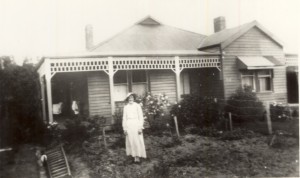
‘Glen Valley’ with lattice added to the veranda and the garden further developed.
HOUSE-WARMING. — Mr E Britton has built a spacious residence at Christmas Hills. On Easter Saturday night the residents wended their way to give Mr and Mrs Britton a house-warming. A very pleasant evening was spent and cheers were given for Mr and Mrs Britton. During the evening items were rendered by Mrs P Streets, Miss E Dunn, and Messrs S Rowe, O Murphy, T Hine, A Rowe, R Dunn, and E Rowe. Excellent music for the dancing was supplied by Mr Y Wilson. Mr P Streets very capably carried out the duties of MC.[1]
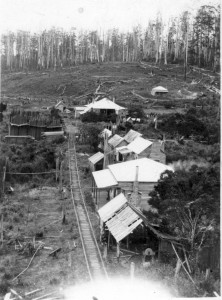
View from the chimney of the original sawmill, showing the blacksmith’s shop (foreground), workers’ cottages (middle distance) and the Britton family house (background). The tramway pictured was used to supply wood to the house. The Bass Highway would later separate ‘Manuka’ from the other buildings.
This was long before electricity or sewerage came to the bush. The toilet was a kerosene tin in a little hut behind the house. Once or twice a week the kerosene tin was emptied, the effluent being buried in a hole.[2]
The mill workers’ cottage vacated by Elijah’s family became Mark Britton’s quarters, where he slept and did the office work. Once a year Lorna washed his blankets and scrubbed his dirty floors. Mark was in the habit of piling bark, sticks and firewood against the inside wall of his office. ‘This was clean dirt, so I’d take that out and scrub that room, but the bedroom was the worst’.
‘Our home was his real home’, Lorna remembered. ‘He had his special place at the table and sat one side of the fireside of an evening in the lounge chair opposite Father all the years he lived with us’.[3]
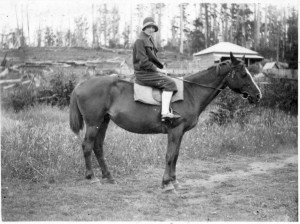
Lorna Britton leaving for a painting lesson on the ‘scary’ light chestnut draughthorse Boxer. She wrote that this horse was ‘so skittish he could toss me off his back easily, but boy could he trot. On the way to Smithton with the drains on each side of the Mowbray Swamp, it was a nightmare to have this scary horse. A passing car could make him jump sideways and you’d end up in the huge drain’. In the background is the cottage behind ‘Manuka’ which was used by workers at the mill, and in which Philip and Maria Britton also stayed.

An unusual shot of a middle-aged Annie Britton smiling.
Right from the start, Annie had recognised the need to diversify and, especially that farming, as well as timber, was needed to sustain her family. Her duties in the home were so many and so laborious that she was run off her feet. Even as her children were growing up and leaving home, Annie suffered with quinsy and a sore throat. She had her tonsils removed late in life in hope of fixing the latter problem. During the winters, her seasons of greatest suffering, the burden of the housework and childcare fell upon her eldest daughter Lorna:
Mother was either too sick or too busy to give the children much love, and I lavished all my affection on those kids. I never knew Mother to be affectionate to me or Phil, and we missed out there.
I was amazed to hear someone say they didn’t know I did anything other than play the violin and piano, paint, and be a lady. Maybe I did when they knew me, but who did the helping where there was no hot water and electric power and light? I would do the last tea dishes in a dish of hot water on the kitchen table by the light of one candle, and put away the meat that came late. It had to be lightly salted and put in the meat safe in a cool place. Mother would already be in bed, and I’d still be working till 8 or 9 o’clock.
Lorna remembered the young Ken as ‘The Little Comforter’ because with a twinkle in his eye he could bring a smile to Annie’s face
He loved the farm animals and could find a calf that had strayed or been hidden by its mother, or a hen’s nest. At that time the common swear word was ‘cussed’, heavily emphasised. I never heard my father, uncle or brothers swear, so Ken came running in at the lisping stage, clutching an egg and shouting ‘I heard a dusserd hen dackle, and I runned over and bruted her off the nest’. It was a favourite saying around the mill for a long time and caused many a happy moment.
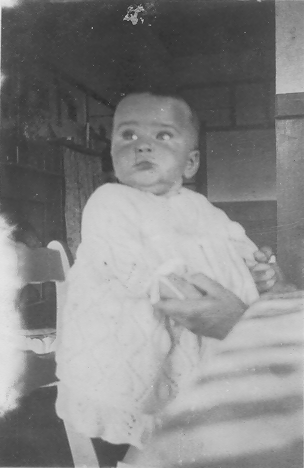
Ken Britton at six months of age in 1921.
The next-youngest boy John was ‘a frail little chap’ who developed eczema so badly that, despite medical treatment, Lorna feared his earlobes would drop off:
But he survived, and I cared for him until I was sent away to school in Launceston for one year. When I left school he was still weak and sickly, suffering many colds and Mother and I sat up more nights than I wish to remember when he had croup and we tried with limited medical care to ease his suffering.
One night he was so distressed that Mother, with her face set in anguish, left the room and brought in a spoonful of something which she poured down his little throat and soon brought relief. What it was I never really knew, but it was probably something that her mother had given her as a child. I think the mixture contained turpentine.
Both feared he would not ‘make old bones’, but John would prove them wrong.[4] Unfortunately, to do so, he would have to survive an accident in which his legs were crushed.

Lorna Britton at Broadland House, Launceston, 1923.
As Elijah and Annie’s children grew, the role of mail and meat bearers fell to Eva, Frank and Ken in turn. By that stage the house the Brittons formerly occupied at Christmas Hills had been enlarged to become the new school, and a public hall had also been raised nearby by public subscription. In 1922 the school graduated from a subsidised school to an ordinary state school, with Irene Dunn continuing as teacher.[5] It was in the unfinished school building that 15–year–old Lorna Britton was farewelled when she left for Launceston to finish her education at Broadland House Ladies’ College (now part of Launceston Church Grammar School):
Dancing was the order of the evening … a presentation of an Xylonite brush and comb and a very handsome box of writing material was made by Mr. C. Burton on behalf of the residents of Christmas Hills to Miss Britton to remind her of those she was leaving behind. Mr. Roy [sic: Phillip Raymond] Britton on behalf of his sister, thanked all for the kind wishes and the presents given to Lorna. The singing of “For she’s a jolly good fellow” terminated a very enjoyable evening.”[6]
[1] ‘Christmas Hills’, Circular Head Chronicle, 26 April 1922, p.3.
[2] Frank Britton memoir, 16 December 1992 (QVMAG).
[3] Lorna Britton notes1983.
[4] Lorna Britton notes 1983.
[5] ‘Xmas Hills Picnic Sports’, Advocate, 21 March 1923, p.6.
[6] ‘Christmas Hills: farewell’, Circular Head Chronicle, 14 February 1923, p.2.
by Nic Haygarth | 06/11/16 | Britton family history, Circular Head history
The dolomite swamp that took the name of the Brittons Swamp is thought to be a polje, that is, a centrally-draining dolomite sinkhole. Dismal Swamp, the selectively logged hollow now operated as a tourist venue, is an almost intact version of the same sort of feature.[1]
Beyond the basalt hills, on the dolomite swamp beyond, Mark Britton found huge stands of blackwood and saw a better future than he and his brother expected to get in the Mallee. He and Fred Oehm selected 200 acres each. Summoned over by his brother, Elijah selected 200 acres adjoining Fred’s block and which contained both hardwood and blackwood.
Phil Britton’s earliest memories of Tasmania were of arriving on the Holyman steamer the Marrawah at Burnie as a two-year-old. His sister Lorna was a babe in arms. From Burnie the family travelled by Tatlow’s horse-drawn coach south of the Sisters Hills and along the beach to Stanley, then changed coach to cross the old Sand Track over Tier Hill to Smithton.[2] Smithton had its own port at Pelican Point, from which timber was exported. Blackwood staves were already fetching a market on the mainland. On one occasion when Elijah and Harold braved the rough crossing on a timber ketch to Melbourne,
the skipper said, ‘If you blokes like to hop in and help load up these blackwood staves we will be away quicker.’ A certain Robert Pratt [junior] was also there and he did help. While Dad and Harold carried the staves on by the armful, R Pratt senior took one at a time. ‘For sure’, he said, ‘the pay will be the same’.[3]

(Left to right) Elijah, Mark and Harold Britton. Twenty-year-old
Harold Britton married nineteen-year-old Laura Fixter
in 1909 and moved to Leongatha, Victoria.

Christmas Hills State School, 1911, with five-year-old Phil Britton (arrowed) front row at left. The teacher pictured is probably Fred Parsons. The original school was a room provided by Tommy and Lizzie Hine, who also lodged the teacher and kept the post office. This was a ‘subsidised’ school, which relied upon the regular attendance of a set number of students and the community providing suitable lodgings for the teacher.
For two years the family lived in a cottage on a small acreage opposite the post office at Christmas Hills, with Elijah only coming home from the mill (four kilometres away) at weekends. While Harold Britton soon dipped out of the business, Mark and Elijah proved an ideal partnership. Elijah, a skilled, mostly self-taught blacksmith, filled the roles of engineer, saw doctor, stoker and timekeeper. He could repair anything mechanical, improvising as needed, and also manned the docker saw. Mark was a fine benchman, an expert at minimising wastage when cutting blackwood. His niece Lorna Haygarth (née Britton) recalled him even bemoaning the fate of heavy timber ends destined for the family fire:
Taking his pipe out of his mouth and putting it carefully on the hearth, he would declare, ‘What a waste, burning this beautiful wood. It should be kept and made into useful articles. Just look at the grain and lovely figure in this piece. It’s real timber, not like some of the pencil wood—it’s heavy, real heavy.’[4]
Mark was a good bullock and horse-driver and had the business brain, keeping the books. Above all, he was a positive thinker. This was essential, because the sight of a five–ton boiler being eased up the Sandhill to the Brittons Swamp site by a twelve–bullock team and a block and tackle signalled the start of a tremendous struggle for survival.

Building the Marrawah Tramway: bridging the Welcome River, 1913. From the Weekly Courier, 13 March 1913, p.20.
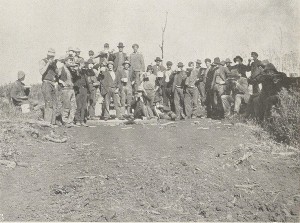
Free beer celebration for the construction party at Christmas. From the Weekly Courier, 13 March 1913, p.20
With government reluctant to build roads to bush selections, economic survival in almost impenetrable forest depended on sawmillers making their own path to market. The Marrawah Tramway (1912?–61) was started by JS Lee in order to harvest the timber on the Mowbray Swamp, epitomising the self-sufficiency and initiative of the early Circular Head sawmilling industry. The state government took over the tramway and extended it to Marrawah on the west coast. Then private timber tramways radiated from the Marrawah Tramway into the Montagu, Brittons, Arthur River and Welcome Swamps.[5]
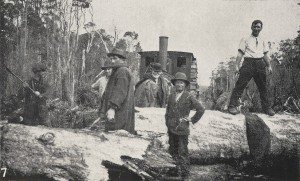
A blockage on the Marrawah Tramway. From the Weekly Courier, 13 October 1921, p.28.
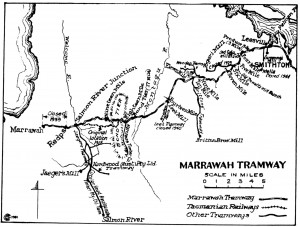
The Marrawah Tramway enters the dolomite Mowbray and Montagu Swamps on its journey from Smithton to Marrawah. Brittons’ branch tramway penetrates Brittons Swamp.
Map by ‘Wanderer’, ‘Railways and Tramways of the Circular
Head District’, Australian Railway Historical Bulletin no.168, October 1951.
Brittons’ line linked their mill to the 9¼-mile mark of the Marrawah Tramway. The 3’6”-gauge Britton Tramway cost about £2,000, a small fortune then. It originally used white myrtle spars for stringers, and was closely corded and ballasted with sawdust so that the five-horse team could haul the trucks of sawn timber (two at a time) without tripping. After a few years, heavy, long hardwood stringers were substituted for the white myrtle ones, and iron rails were placed on the outside bends. Twelve loading ramps enabled twenty-four loads of timber to be left at the junction with the Marrawah Tramway. The timber was then delivered to the Pelican Point jetty at the Duck River heads, where it was loaded on ships bound for Melbourne or Adelaide.[6]
Specialisation in blackwood, supplemented by production of hardwood and other timber, established the Britton’s seasonal regime. The swampy habitat of blackwood made haulage in the drier months essential, with strong, stoic bullocks being favoured for this task. (Horses were preferred to haul hardwood from the drier eucalypt forest.) Logging, cutting and carting in summer gave most of the men a job under cover, milling, in winter, when the weather was bad. In the winter of 1919, for example, Brittons milled about 8,000 super feet (24 cubic metres) of logs per day.
Loss of valuable horses to colic and falling trees prompted the purchase of a 1910 Buffalo and Pitts traction steam engine, which crushed culverts beneath it as it chugged from Forest to its new home. It was fuelled by the abundant wood and water. Elijah Britton devised a cog system which enabled the steam engine to be converted from road to rail, and the tramway was upgraded accordingly. The Buffalo and Pitts hauled sawn timber out to market on the tramway, back-loading with stores. When its boiler eventually rusted out, the engine was replaced by a 1904 Marshall single-cylinder traction engine, which had a better boiler and was a better steamer.
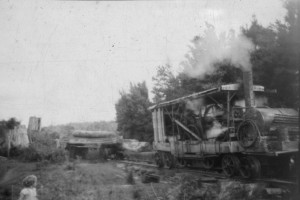
Bush engineering. The Marshall loco, seen here hauling a load of blackwood, was a triumph of improvisation.
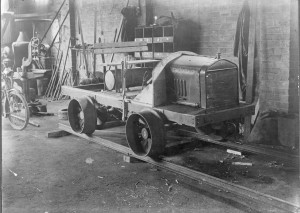
Brittons also had this Model T-Ford converted into a dynamic rail motor by Arthur Schmidt of Burnie.
Brittons’ transport problems didn’t end with delivery of timber to the Marrawah Tramway, as the following example illustrates. In 1918 Brittons reached an agreement with Cummings & Co to share the 20,000 super feet of space available on the Holyman steamer ss Hall Cain after JS Lee & Sons had loaded up their guaranteed shipment of 50,000 super feet. Brittons were to ship 15,000 super feet of hardwood to its agents in Melbourne, and delivered this timber to its junction on the Marrawah Tramway. However, timber was already stacked in the way at the junction, including seasoned blackwood owned by Cummings. This forced Brittons to load Cummings’ blackwood onto the vessel before they could load their own hardwood, leading to a dispute between the two companies. Brittons demanded and eventually gained compensation from Cummings.
[1] See Kevin Kiernan, An atlas of Tasmanian karst, Research report no.10, Tasmanian Forest Research Council Inc, Hobart, 1995.
[2] Phil Britton, ‘First Impressions of Brittons Swamp’; ‘The Britton Family’ (notes held by Britton family).
[3] Phil Britton, ‘First Impressions of Brittons Swamp’ (notes held by Britton family).
[4] Lorna Haygarth (nee Britton), ‘The Britton Story’ (notes held by the Britton family).
[5] ‘Wanderer’, ‘Railways and Tramways of the Circular Head District’, Australian Railway Historical Bulletin, no.168, October 1951, pp.151–52.
[6] Phil Britton, ‘The Britton Family’, pp.5–7 (notes held by Britton family).


















